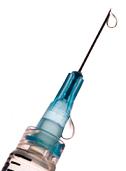Advertisment
Dramatic decline in genital wart rate among young women in Australia results from National HPV Vaccine Program

by Bruce Sylvester – taken from the BMJ – Researchers have reported a significant decline in the proportion of young women diagnosed with genital warts in Australia following the implementation of the national HPV vaccine program. The finding was published by the British Medical Journal online on April 18, 2013.
In 2007, Australia implemented a national quadrivalent human papillomarivus (HPV) vaccination program, offering free vaccinations to girls aged 12-13 years at school sites. From 2007 – 2009, two catch-up programs took place for 13-18 year-olds and 18-26 year-olds.
The vaccine protects against the types of HPV that cause 90% of genital warts, and cancer-causing HPV types.
Findings at two years, previously reported, showed that two years after the program began, diagnoses of genital warts had declined by 59% in vaccine-eligible women aged 12-26 years and by 39% in heterosexual men. There was also a significant decrease in the incidence of high-grade cervical abnormalities in females under 18 years.
In the new analysis, researchers from the University of New South Wales and Melbourne Sexual Health Centre evaluated the ongoing effects of the vaccination program, five years after it began. Australian-born subjects who received any of the services for the first time between January 2004 and December 2011 were included in the analysis.
The researchers divided the study into the pre-vaccination (2004-2007) period and vaccination period (2007-2011). They separated the findings by three age groups– those under 21, 21-30 year olds and those 30 and older.
Between 2004 and 2011, 85,770 subjects were seen for the first time, and, 7686 (9%) were diagnosed with genital warts.
The proportion of women with genital warts increased during the pre-vaccination period, from 9% in 2004 to 10% in 2007, and then decreased during in the vaccination period to 3%.
Among men, the proportion with genital warts remained stable in the pre-vaccination period, from 13% in 2004 to 12% in 2007.It decreased during the vaccination period to 7%.
In women under 21, 9% were diagnosed with genital warts in 2004 and 11% in 2007. During the vaccination period the proportion declined dramatically to 0.85%.
In 2011, none of the vaccinated women under 21 were diagnosed with genital warts, and 7% of unvaccinated women under 21 were diagnosed with genital warts.
The investigators reported significant declines in genital warts among women aged 21-30 and heterosexual men under 21 and aged 21-30 years, during the vaccination period. They cited the male results as “herd-immunity,” or immunity that occurs when the vaccination of one portion of the population provides some protection for individuals who have not developed immunity.
They reported no significant trends in women or heterosexual men over the age of 30.





